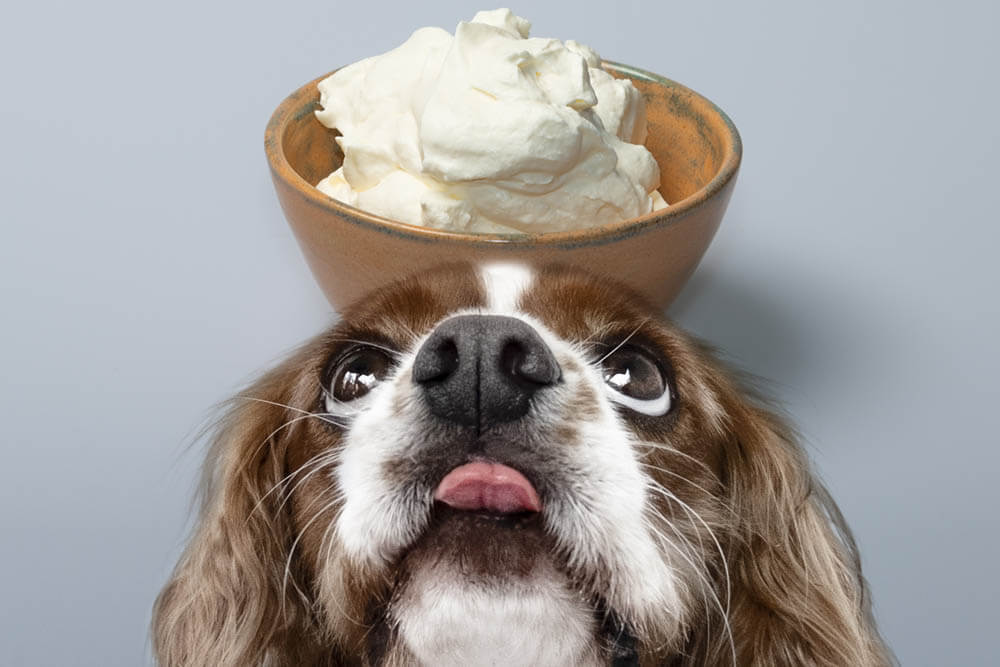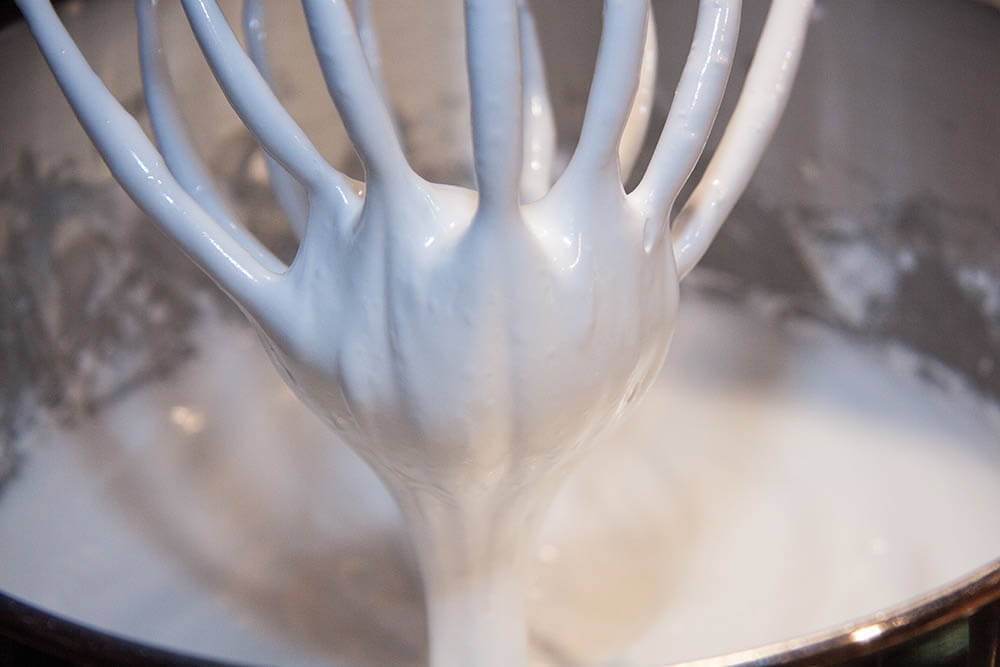Whipped cream is a sweet delicacy that’s created by using a mixer or whisk to beat heavy cream until it’s light and fluffy. It sometimes contains flavoring and is often used as a dessert topping.
It’s not a good idea to feed dogs whipped cream.
Regular whipped cream isn’t toxic to dogs. It can even be enjoyed without causing any issues. However, its components are known to make some dogs ill. And if eaten regularly, whipped cream can cause serious harm.
Then there’s whipped cream that’s been artificially sweetened using xylitol – a chemical that’s extremely toxic to dogs.
Read on as we discuss how whipped cream can affect a dog!

What’s wrong with feeding dogs whipped cream?
The main components of whipped cream are sugar and cream. Sugar is unhealthy for dogs. Cream is a problem for dogs that can’t tolerate dairy.
The other substances found in whipped cream can also make a dog ill.
If a dog eats whipped cream, they may experience the following problems:
Digestive issues
The sugar used in whipped cream isn’t natural to dogs. When this sugar enters the canine gut, it may cause an imbalance in the gut bacteria populations, leading to:
- Vomiting
- Diarrhea
- Flatulence
- Abdominal pain
Some dogs are more prone to such issues than others. Ask a vet for advice if your pet experiences digestive problems after eating whipped cream. If their symptoms are severe, bring them to a pet clinic or hospital for treatment.
Lactose intolerance
If your dog is lactose intolerant, eating dairy such as whipped cream can cause:
- Vomiting
- Diarrhea
- Abdominal pain
- Bloating
- Dehydration
- Extreme thirst
- Weakness
- Breathing difficulty
- Weight loss
The best way to treat and prevent lactose intolerance is to simply avoid feeding your dog dairy.
Dairy allergy
Eating dairy can also provoke an allergic reaction in a dog. Dairy allergy usually manifests as itchy skin and skin rashes, which can provoke excessive scratching or chewing of the paws and other body parts. Such actions may, in turn, lead to hair loss.
If the allergy symptoms are severe, you should take your dog to the vet. To get better, your dog will likely have to go on a special diet.
Deadly poisoning
Sugar-free whipped cream varieties exist for the benefit of people watching their weight.
How does this type of whipped cream stay sweet? Simple: it uses an artificial sweetener called xylitol.
When absorbed by a dog’s body, xylitol drastically lowers their blood sugar levels, which can cause liver damage, liver failure, and even death.
The symptoms of xylitol poisoning include:
- Upset stomach
- Decreased activity
- Exhaustion
- Weakness
- Incoordination
- Staggering
- Shivering
- Seizures
- Collapse
- Unconsciousness
- Coma
Symptoms can occur 10 to 60 minutes after xylitol ingestion. However, some dogs can go as long as 24 hours without experiencing problems. Therefore, dog owners shouldn’t assume a pet that’s consumed xylitol is safe just because they haven’t displayed toxicity symptoms yet.
Any amount of xylitol can harm a dog whatever their size, age, and breed. So if your doggo consumes whipped cream that contains xylitol, bring them to the vet immediately for emergency treatment.
Whipped cream is sometimes flavored using vanilla. Vanilla extract contains alcohol, which is toxic to dogs. Avoid giving your pet vanilla-flavored whipped cream as it can cause everything from indigestion to death.
Whipped cream flavored with coffee or chocolate is also toxic, so never feed such food to your dog.
Whipped cream is high in sugar and fat, so a dog that eats it frequently can gain unhealthy weight. Over time, this can lead to obesity.
Obesity increases the risk of many health problems, including:
- Joint pain and osteoporosis
- Diabetes
- Heart disease
- Hypertension
- Various cancers
- Urinary bladder stones
- Heatstroke
Obesity also makes regular physical activities more challenging, which discourages them from participating in the exercise they need to lose weight.
For such reasons, obesity reduces a dog’s quality of life and even shortens their life expectancy.
High blood sugar levels
Eating sugary food raises your dog’s blood sugar levels. Regular whipped cream consumption maintains those elevated levels, which can cause a dog to experience:
- Dehydration
- Extreme thirst
- Depression
- Reduced energy
- Seizures
- Coma
Prolonged elevation can even lead to kidney disease, heart disease, stroke, pancreatitis, and diabetes.
Sugar addiction
Dogs can get addicted to sugar. If you feed your dog lots of whipped cream, they may become obsessed with the food and start rejecting healthier options as a result. A lack of good nutrition leaves a dog susceptible to illnesses and infections.
Dental caries
Consuming sugar stimulates the bacteria in your dog’s mouth to produce acid; the more sugar a dog eats, the more acid is produced.
This excess acid corrodes the enamel (the teeth’s hard outer layer), eventually resulting in cavities. Untreated cavities can become painfully infected or even lead to tooth loss.

Feeding dogs whipped cream
Again, we don’t recommend feeding dogs whipped cream. However, if you’re adamant about having your dog enjoy this treat, keep the following tips in mind:
Consult a vet
Before feeding your dog anything new, always consult a vet first. A vet will determine whether or not your dog can safely eat this new food as well as the serving size and frequency that’s most appropriate for them.
Consider your dog’s health
The consumption of fatty, sugar-rich food can make certain conditions grow worse. So don’t feed your dog whipped cream if they have any of the following issues:
- Diabetes
- Heart disease
- Hypertension
- Liver disease
- Obesity
- Lactose intolerance
- Dairy allergy
Consider your dog’s age
Puppies and elderly dogs don’t need as much energy as adult dogs, so consuming sugar-rich whipped cream is exceptionally unhealthy for them.
Check the food label
Check the whipped cream’s food label. If it contains xylitol, don’t feed it to your dog as it will make them seriously ill.
If you’re ordering whipped cream from a restaurant, ask a knowledgeable member of the establishment whether it contains sugar or xylitol.
Feed your dog whipped cream occasionally only
There’s no rule for how much sugary whipped cream a dog should eat per week. However, we recommend a portion about the same size as any of their paws. You can feed them this amount around two times a week, though remember that the less they eat, the better.

Whipped cream FAQs
Now that we’ve answered the major questions about whipped cream, here are more commonly asked questions about whipped cream as food for dogs:
What do I do if my dog eats whipped cream?
Check the label. If the whipped cream contains xylitol, bring your dog to the vet immediately.
Did they eat sugary whipped cream? If your dog ate a small amount, don’t panic; either they won’t get ill or they’ll experience nothing worse than mild digestive issues and/or a temporary drop in appetite.
But if more than the recommended amount was consumed, you may see vomiting, diarrhea, and other digestive problems. Such symptoms usually go away by themselves, but if they persist, seek veterinary aid.
The symptoms of lactose intolerance also disappear over time.
If your dog is allergic to dairy, contact a vet for help.
If a vet isn’t available, those in North America can contact the Pet Poison Helpline at (855) 764-7661, instead.
Can dogs eat Puppuccinos from Starbucks?
A Puppuccino is essentially a cup of whipped cream. While it doesn’t contain ingredients that can seriously harm a dog, it’s still an unhealthy treat that’s best enjoyed occasionally.
Make sure your dog isn’t lactose intolerant or allergic to dairy before giving them a Puppuccino.
Can dogs eat Cool Whip?
Yes, but only as an occasional treat as it’s highly fattening. Check the food label for xylitol.
Can dogs eat Reddi Whip?
Reddi Whip is also fattening, so it should only be eaten occasionally. Again, check the food label for xylitol.
Can dogs eat unsweetened whipped cream?
This is probably the healthiest kind of whipped cream you can give your dog. It still contains fat, however, so it’s also best eaten in moderation.
Can dogs eat sweetened whipped cream?
Only if it doesn’t contain xylitol. There are sweeteners that won’t harm your dog as long as they’re eaten in moderation, but avoid xylitol at all costs as it can kill your dog.
Can dogs eat light whipped cream?
Light whipped cream usually contains xylitol or sugar-rich corn syrup. Xylitol is toxic to dogs. Corn syrup can cause many of the issues associated with sugar consumption, including digestive problems and obesity. Don’t give dogs light whipped cream.
Can dogs eat non-dairy whipped cream?
Almond milk, coconut, and vegan whipped cream can all be eaten safely as an occasional treat. Just keep your dog’s allergies in mind, and check the labels for xylitol.

Conclusion
Because whipped cream is unhealthy for dogs, you should only feed it to your pet as an occasional treat. Or better yet, don’t feed your dog whipped cream at all.
If your dog experiences problems after eating whipped cream, don’t hesitate to contact a vet!
